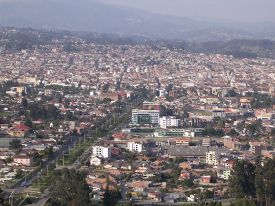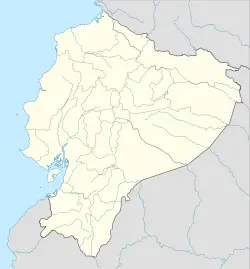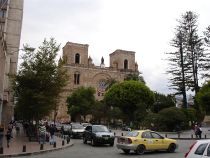Cuenca, Ecuador
| Cuenca | |||
| — City — | |||
| Santa Ana de Los Cuatro Ríos de Cuenca | |||
|
|||
| Nickname: Atenas del Ecuador (Athens of Ecuador) | |||
| Location in Ecuador | |||
| Coordinates: {{#invoke:Coordinates|coord}}{{#coordinates:2|53|57|S|79|00|55|W| | |||
|---|---|---|---|
| name= }} | |||
| Country | Ecuador | ||
| Province | Azuay | ||
| Canton | Cuenca | ||
| Founded | April 12, 1557 | ||
| Founder | Gil Ramírez Dávalos | ||
| Named for | Cuenca, Spain | ||
| Parishes | Urban Parishes
|
||
| Government | |||
| - Mayor | Hugo Marcelo Cabrera Palacios | ||
| Area | |||
| - City | 67.71 km² (26.1 sq mi) | ||
| Elevation | 2,560 m (8,399 ft) | ||
| Highest elevation | 2,550 m (8,366 ft) | ||
| Lowest elevation | 2,350 m (7,710 ft) | ||
| Population (2000)INEC decadal national census | |||
| - City | 467,000 | ||
| - Density | 6,897.1/km² (17,863.3/sq mi) | ||
| - Metro | 617,632 | ||
| The population total is of the urban parishes of the Municipality of Cuenca (the canton), which make up the city of Cuenca; the metro population is the population of the canton. | |||
| Time zone | ECT (UTC-5) | ||
| Demonym | Cuencano(-a) | ||
| Website: http://www.municipalidadcuenca.gov.ec/ | |||
Cuenca (full name Santa Ana de los cuatro ríos de Cuenca) is the third largest city in Ecuador in terms of population. It is located in the Sierra, the highlands of Ecuador, at about 8,200 feet (2,500 m) above sea level. The center of the city is listed as a UNESCO World Heritage Trust site because of its historical buildings. Cuenca is an outstanding example of a planned inland Spanish colonial city.
The original settlement was conquered by the Incas less than half a century before the conquistadors landed. Inca ruler Tupac Yupanqui ordered the construction of a grand city, a second Inca capital. Indians relayed stories to the Spanish of golden temples and other wonders, but by the time the Spaniards found the legendary city all that remained were ruins, leaving uncertainly about what had happened. For that reason, Cuenca is considered a candidate for the mythical city of gold, El Dorado, which is believed to have been burned by the inhabitants themselves in response to rumors of Spanish conquests.
Geography
Cuenca, capital of the province of Azuay, is located in the Andes in the southern region of Ecuador. The city ranges from 2,350 to 2,550 meters above sea level. The dominant features of the city's geography are also the source of its name: four rivers (the Tomebamba, Yanuncay, Tarqui, and Machangara, in order of importance). The first three rivers originate in the Páramo of Parque Nacional Cajas to the west of the city. These four rivers are part of the Amazon River watershed. Cuenca (meaning a basin caused by a confluence of rivers) is surrounded by mountains on all sides, with passes to the west, south, and east.
Climate
Like the rest of the Ecuadorian Andes, Cuenca enjoys a mild climate year-round. Days are generally warm and nights are cool. The average daily temperature is 14.6 degrees Celsius. There are two seasons: rainy and dry. The dry season, with some variation, falls between June and December. The rainy season, which is characterized by bright sunny mornings and afternoon showers, falls between January and May. The heaviest rains come in the invierno of March, April, and May.
History
First inhabitants
According to archeological discoveries, the origins of the first inhabitants go back to the year 8060 B.C.E. in the Cave of Chopsi. They were hunters and nomads. Tools like arrows and spears have been found throughout the Andean valley.
The early inhabitants used the stable climate, fertile soil, and abundant water to develop agriculture. They grew potatoes, melloco (a juicy plant with a creeping stem, the sprouts of which swell at the tips into tubers), chocho (a type of gourd), squash, and quinoa, to name a few. They also domesticated animals such as cuy (guinea pigs), llamas, and alpacas.
Their technology also advanced; they started using ceramics, which are the main archaeological material from which to study their culture. Little has been found from the period between 5000 and 2000 B.C.E. A more organized society began around 2000 B.C.E., demonstrating delegated responsibilities like managing water and control of plagues, and there was a differentiation between administrative and religious authorities (known as shamans). This occurred during the Periods of Chaullabamba, Huayco, Pirincay, Monjas, Putushio, Huancarcucho, and Jubones. From then until 500 C.E. began the periods of Tacalshapa III and Cañari.
Pre-Columbian society
Cuenca was originally a Cañari settlement called Guapondeleg and is believed to have been founded around 500 C.E. Guapondeleg translates into "land as big as heaven." Less than half a century before the conquistadors landed, the Incas, after a bitter struggle, conquered the Cañari and occupied Guapondeleg and the surrounding area. Though the Incas replaced the Cañari architecture with their own, they did not suppress the Cañari or their impressive achievements in astronomy and agriculture. These, as was customary for the Incas, were absorbed into their culture. The city was then renamed Tomebamba. The city became known as the second Cusco.
Shortly after the defeat of the Cañari, the Inca commander, Tupac Yupanqui, ordered the construction of a grand city - Pumapungo, "the door of the Puma" - whose magnificence was to challenge that of the Inca capital of Cuzco. Indians relayed stories to the Spanish chroniclers of golden temples and other such wonders but by the time the Spaniards found the legendary city all that remained were ruins, leaving everyone to wonder what happened to the fabled splendor and riches of the second Inca capital. After being abandoned by the Cañari and then the Incas, Cuenca was sparsely populated until the 1550s.
Cuenca is considered a candidate for the mythical city of gold, El Dorado. El Dorado is believed to have been burned by the inhabitants themselves when rumors arose of Spanish conquests. Tomebamba's destruction by its inhabitants prior to the arrival of the Spanish lends credence to the theory that it was El Dorado. Tomebamba was founded by the Incas as a second imperial capital, as noted above.
Spanish settlement
Cuenca was founded on April 12, 1557 by the Spanish explorer Gil Ramírez Dávalos. The foundation of the city was commissioned by Andrés Hurtado de Mendoza, the Viceroy of Peru at the time. Hurtado de Mendoza had the city named after his home town of Cuenca, Spain. The date of the foundation is notably later than other major Ecuadorian cities founded at the time, such as Quito (1534), Guayaquil (1538), and Loja (1548).
This inland colonial town was founded on the rigorous planning guidelines issued 30 years earlier by the Spanish king, Charles V. Cuenca still observes the formal orthogonal town plan that it has respected for 400 years. Today, Cuenca illustrates the successful implantation of the principles of Renaissance urban planning in the Americas. Its layout also demonstrates the successful fusion of different societies and cultures in Latin America.
Cuenca achieved its independence on November 3 1820. Cuenca's population and importance grew steadily during the colonial era and reached the peak of its importance in the first years of Ecuador's independence; it became the capital of one of the three provinces that made up the nascent republic. The other two capitals were Guayaquil and Quito.
Demographics
As per the last census, the population of the Cuenca canton was 417,632, of whom 267,000 constitute the urban population (i.e., the population of the city proper).
Economy
Economic development is based on industry and agricultural development. Cuenca has a longtime reputation for being a university city. It hosts eight universities, the oldest and best known being University of Cuenca (Universidad de Cuenca), a public university with about 12,000 students.
One of the region's agricultural and administrative centers, it has been a melting pot for local and immigrant populations. Cuenca's architecture, much of which dates from the eighteenth century, was 'modernized' in the economic prosperity of the 19th century as the city became a major exporter of quinine, straw "Panama" hats, and other products. The hats are made from the leaves of the toquilla palm. Much of the quinine bark of Ecuador is shipped from Cuenca, and the city is also a center for the trimming, stitching, and shipping of Panama hats, so called because of their former center of distribution. Other industries in the city are the refining of sugar, the manufacture of woolen goods and pottery, and the shipping of grain, hides, and cheese.
Culture
| Historic Centre of Santa Ana de los Ríos de Cuenca* | |
|---|---|
| UNESCO World Heritage Site | |
File:Cuenca1.jpg Cuenca's stone streets. | |
| State Party | |
| Type | Cultural |
| Criteria | ii, iv, v |
| Reference | 863 |
| Region** | Latin America |
| Inscription history | |
| Inscription | 1999 (23rd Session) |
| * Name as inscribed on World Heritage List. ** Region as classified by UNESCO. | |
Most tourists visit the historic area, which is a UNESCO World Heritage Site, located between the river Tomebamba and the street Gran Colombia to the north, General Torres to the west, and Hermano Miguel to the east. This area's compactness, grid-like layout, and numerous readily identifiable monuments make it easy to navigate. Outside this area the city can be confusing, as there are dozens of narrow colonial streets with similar buildings. There are 52 churches in the historic area, though many are closed now due to lack of priests.
Major fiestas of Cuenca come at the time of the "Mass of Children" that is carried out the day of the Arrival of Kings (January 6th - Epiphany Day), or in the commemoration of the independence of the city (November 3rd), during which processions, cultural acts and dances are organized.
The nearby Cañar plantation (in the county of the same name) features the biggest Inca ruins in Ecuador.
Landmarks
- Old cathedral
- It was built in 1557, but soon was too small for the faithful of the town. In 1880, they decided to build a temple to replace it. At the present time, the old cathedral is in process of restoration. It is no longer consecrated and is operated as a museum.
- New cathedral (official name: Catedral Metropolitana de la Inmaculada Concepción)
- Its towers are truncated due to a calculation error of the architect. If they had been raised to their planned height, the foundation of this church to the Immaculate Concepcion, would not have been able to bear the weight. In spite of the architect's immense mistake, the New Cathedral of Cuenca is a monumental work of faith that began to be built in 1880. It is in Neo-Gothic style, and its blue and white domes have become a symbol for the city. Its facade is made of alabaster and local marble, while the floor is covered with pink marble, brought from Carrara (Italy).When the Cathedral was first constructed 9,000 out of Cuenca's 10,000 inhabitants could fit.
- Park Abdon Calderon
- It is in the center of Cuenca between the old and new cathedrals. On the park benches, people meet to converse and absorb its tranquility. The municipal offices are located nearby.
- Monastery of El Carmen de Asuncion
- In the atrium a colorful flower market supplements the beauty of the church which was founded in 1682. A sculpted stone facade and a golden pulpit make the church very attractive.
- Monastery and Museum of La Concepcion
- Tombs of the XVII century and a complete collection of religious art are part of this exhibition.
- House of the Ecuadorian Culture
- Municipal Museum Remigio Crespo Toral
- Museum of the Central Bank
- Museum of the Aboriginal Cultures
- Church of Santo Domingo
- San Blas.
- Ruinas de todos los santos
- In this old place, four niches of Inca origin exist. Their form is trapezoidal and they are built of stone. There are also remains of a colonial mill.
Surroundings
- Jima
- The community of Jima is located near Cuenca and is a hiking hotspot for Southern Ecuador. Jima is located at the base of two beautiful green mountains at 8,800 feet. Hikes for all skill levels are available including a three day hike from the peaks of the Andes mountains down into the lush tropical rainforest of the Amazon basin.
- Gualaceo
- Chordeleg
- Less than 50 kilometers from Cuenca, town of Cañari origin, known for its weavers, embroiderers and potters. In the same area there is a stone corridor in snake form, built in pre-Inca time, known for gold and silver smiths and local jewelry.
- El Cajas
- A national park where the rivers, streams and lagoons seem to unite, to create a temple of nature, in which the altitude varies from the 3500 to the 4200 m.a.s.l. It is a place for bird watchers and trout fishermen.
- Azogues
- Azogues is the capital of Cañar Province, 29 kilometers separate it from Cuenca. In this city of colonial atmosphere, one of the highlights is San Francisco's convent, built on the summit of a huaca (sacred mountain) of the prehispanic residents.
- Cañar plantation
- Their coloring market and the near ruins of Ingapirca (wall of Inca stone), are their biggest attractions. Cañar plantation is located 65 kilometers from Cuenca and it is usually the starting point for the trips to the famous ruins that, according to the experts, were used to control the native Cañaris. Stores, bathrooms, a tambo for the Inca, a temple dedicated to the sun, they are part of Ingapirca that was built in the XV century by orders of Huayna Capac.
Transport
Bus Station
Cuenca's inter-provincial bus station, called the Terminal Terrestre as it is in most cities, is well organized and clean. It is located on Avenida España in the northeastern corner of the city, a twenty-minute walk or a brief taxi ride from the historic center. Also, many municipal buses provide frequent service as indicated by the "Terminal Terrestre" placard on the windshield.
Buses arrive and depart throughout the day. Service is available to major cities, such as Guayaquil and Quito and also to nearby cities and towns, such as Loja, Riobamba, or Machala. The distance to Guayaquil is 243 km. and the bus takes nearly 4 hours on the highway Durán-Pto.Inca-Molleturo, a scenic ride through the Cajas National Park. Quito is 497 km from Cuenca and the trip takes around 10 hours on the Road Pan-American South. Many prefer to travel by bus at night. Those who choose to travel overnight should exercise caution due to reported bus hijacks which have resulted in armed robbery
Airport
The airport, named Aeropuerto Mariscal Lamar, is located due east of the Terminal Terrestre on Avenida España. It's a 5-minute walk from the bus station. Three airlines serve Cuenca in 2007; TAME and AeroGal fly to Quito and Guayaquil daily, while Icaro Air connects only to Quito.
External links
- Official Web Site from Cuenca Ecuador and the people from Cuenca (Spanish)
- TavolaEcuador.com - The first restaurant guide from Cuenca, Ecuador.
- Official Travel Guide To Cuenca, with maps, hotels, restaurants, photos & more information about Cuenca
- Cuenca government
- Cuenca on Wikitravel
- Universidad del azuay
- Cultura, tradición y turismo de Cuenca - Ecuador
- Sightseeing information
Credits
New World Encyclopedia writers and editors rewrote and completed the Wikipedia article in accordance with New World Encyclopedia standards. This article abides by terms of the Creative Commons CC-by-sa 3.0 License (CC-by-sa), which may be used and disseminated with proper attribution. Credit is due under the terms of this license that can reference both the New World Encyclopedia contributors and the selfless volunteer contributors of the Wikimedia Foundation. To cite this article click here for a list of acceptable citing formats.The history of earlier contributions by wikipedians is accessible to researchers here:
The history of this article since it was imported to New World Encyclopedia:
Note: Some restrictions may apply to use of individual images which are separately licensed.







